2009 Yamaha Apex GT Review

The sled that took 4-strokes beyond acceptable
Yamaha might say that it was the company’s RX-1 that made the idea of a performance 4-stroke snowmobile acceptable. We only partially agree. Yes, to us the RX-1 made 4-stroke snowmobiles acceptable, but it was the Yamaha Apex that made 4-stroke snowmobiles believable.
Engine Type:Horizontal In-line
Cylinders:4
Engine Stroke:4-Stroke
Valve Configuration:DOHC
Displacement:998 / 60.9
Starter:Electric
Turbocharged:No
View Full SpecIndeed, if not for online feedback referring to the RX-1 as the ‘Yamaha RX-1-Ton,’ the Apex nomenclature may never have surfaced. But because of the hefty negative online forum feedback about the RX-1’s weight, Yamaha decided to do away with the old name and find a new descriptor for what would be a much more sprightly sled with rider-forward ergonomics, more 4-stroke engine response and, yes, less weight.
Few Changes
At our Colorado mountain test site, we found the 2009 Yamaha Apex GT had few changes from the previous season. When you have a 150-horsepower four-cylinder engine with the response of Yamaha’s fuel-injected Genesis 150FI, there is little reason to mess with success. This is the same basic engine configuration that powered the original RX-1 that caused such a stir among snowmobilers early this decade. At 998cc this 4-stroke quad carries four electronically monitored fuel injection throttle bodies, where the original RX-1 Genesis Extreme motor relied on 37mm Mikuni constant velocity carburetors. The Apex engine gives you instant throttle response that seemingly can spin the track almost any time you crack the throttle lever.
If you don’t like anything else about the Yamaha Apex, you have to love the powertrain. It is the most refined system in snowmobiling. Arctic Cat has more sheer brute force with its turbocharged ‘Z’ model, but Yamaha lays down a level of sophistication that you’d only expect to find in a very pricey sports car or, say a ‘world’s fastest production motorcycle.’ The Genesis 150FI is a direct descendant of the R1 engine, the high revving power that made that Yamaha’s R1 motorcycle one of the most desired street rockets ever.
Genesis 150FI
While the RX-1 powerplant was the turning point to gaining acceptance for 4-stroke sleds, the Apex’ Genesis 150FI makes those early adopters look like in-the-know geniuses. The Apex engine dropped a few pounds through the usage of lighter weight (and more costly) components while adding about eight more horses to its four-cylinder stable.
Of course, borrowing and adapting a motorcycle-specific engine for snowmobile-specific needs required some serious tweaking, to include the use of an engine crankshaft gear drive system to bring primary clutch speed down into the clutch-able range of 8,000-9,000 rpm. Yamaha’s gear reduction took the R1-like top engine speed from about 10,200 revs to the 8,000-plus rev range. The newer Apex GT engine enjoys similar gear reduction so it, too, can assure increased drive clutch and drive belt durability.
Among Yamaha power products the R1 derived quad has become a bit of a ubiquitous engine with versions powering motorcycles, personal watercraft, as well as snowmobiles. But it is snowmobiles where the quad has enjoyed its biggest impact. Where the RX-1 proved a 4-stroke could be an acceptable substitute for a previously 2-stroke-powered performance-oriented snowmobile, it was the Apex that blew past any remaining negatives about 4-strokes being synonymous with hot rod sledding.
This past season we had the use of an Apex GT 40th Anniversary model and learned what life aboard a high-performance snowmobile powered by a 4-stroke was all about. Granted, we have spent some time with Yamaha’s 4-stroke prior to this, but left to our own devices and not under the scrutiny of Yamaha eyes, we got to actually k-n-o-w the sled.
A few miles of a test ride can’t give you the full measure of the digital controls for hand warmers and setting of the electronically controlled rear suspension shock. You can appreciate the full-on blast from the engine on a lakebed speed test, but out riding the trails all alone, you realize that this sled has power better left untapped more often than not. That’s not to say we were afraid of the power, but we discovered that when simply trail riding the Yamaha Apex GT, we rarely passed one-third throttle except when we opened it up for a quick blast on a corridor trail. You can roll quickly through tight trails well under half throttle. Of course, you will want to wail at full throttle every now and then simply to listen to the engine’s exhaust scream.
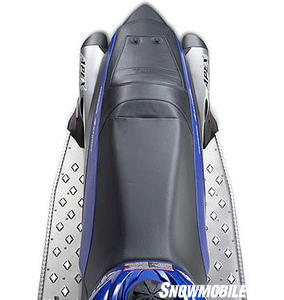 Yamaha owns the patent for underseat exhaust systems.
Yamaha owns the patent for underseat exhaust systems.
When Ski-Doo executives told us earlier this winter that they had worked with a Formula One engine builder to get their new 4-stroke triple to scream like an F1 racer, it must have been as an answer to the wide open throttle sound of a Yamaha Genesis 150FI. Sorry, Ski-Doo guys…Yamaha wins the sound effects battle. Holders of the patent that lets them be the only sled maker able to run their exhaust under the seat and out the back of the sled, Yamaha has this exhaust flow thing well in hand of its competition.
The Genesis 150FI flows exhaust from the four main titanium header pipes into a dual then a singular and back to dual exhaust system. This is a patented design that relieves underhood heat coming from Yamaha’s 4-stroke, serves to cool the exhaust by running it down the tunnel, and helps redistributes weight for better sled balance. And, then, of course there is that sound. Nothing sounds quite like a Yamaha quad at idle — or full throttle!
The Ride Experience
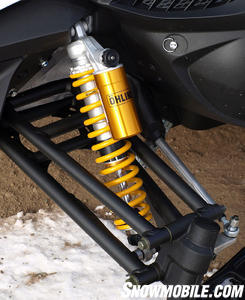 The rear suspension shock is electronically controlled and can be set on the go.
The rear suspension shock is electronically controlled and can be set on the go.
In reality, you’ll experiment with shock settings, but after a few miles when you’ve settled in to riding and given up playing with bells and whistles — of which the Apex GT has plenty — you’ll find the magic setting and won’t play with the suspension any longer. Stutter bumps are handled easily. The front skis bite firmly thanks to the second-generation design of short and long suspension arms. There’s a full nine inches of ‘clicker’ shock controlled travel with a ski stance of more than 42-inches center-to-center.
Ride ergonomics are very good. The runningboards are ample for a size 13 boot and the steering bar is wide with hooked ends, second only to Arctic Cat’s handlebar set.
Our adventures on the Yamaha finally gave us enough time to actually appreciate the digital gauge that includes dual trip meters (set one for fuel mileage and the other for total trip miles). The gauge is also the control module for the hand and thumb warmers as well as control central for setting the rear suspension shock. When riding at brief press introductions, you can play with the settings, but it isn’t until you have a long ride or a season of time to utilize the system that you fully appreciate its value. The symmetry of the design is logical and now that we’ve had a season with the setup we like it a lot.
On Trail
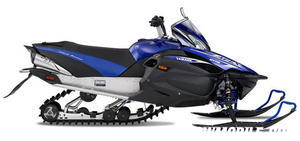 The Apex GT profile shows off its ride-forward seating.
The Apex GT profile shows off its ride-forward seating.
Twenty valves, dual overhead cams, four throttle body injectors, 4-into-2-into-1-into-2 exhaust. With its high-powered personality under the hood and mogul absorbing travel under your fanny, the 2009 Yamaha Apex GT continues to make history for Yamaha with a high-revving 4-stroke legacy that makes this sled a high-performance trail machine by any snowmobiler’s standards.
| 2009 Yamaha Apex GT Specs | |
| Engine | Yamaha Genesis 150FI; 998cc, 4-cylinder, 4-stroke, liquid-cooled; 4 throttle body electronically controlled fuel injection |
| Horsepower | 150 |
| Drive | Yamaha YVXC |
| Front Suspension | Yamaha short/long arm wishbone; 9-in travel; 40mm GYTR dual clicker high pressure gas shocks; 12 clicks of compression/20 clicks of rebound damping |
| Rear Suspension | Yamaha Ohlins Mono Shock electronic control; 11.6-in travel; 46mm Ohlins high pressure gas with electronic compression adjustment, manual rebound adjustable |
| Length | 110.4 in |
| Height | 45.7 in |
| Width | 48.2 in |
| Ski Stance | 42.7 in |
| Track | 15 x 121 x1.25 Rip Saw |
| Weight | 575 lbs. |
| Fuel Capacity | 10.0 US Gal |
| MSRP | US$11,699 |
Related Reading:
2009 Yamaha Phazer RTX Review
2009 Yamaha Preview



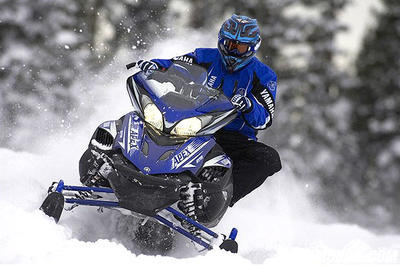
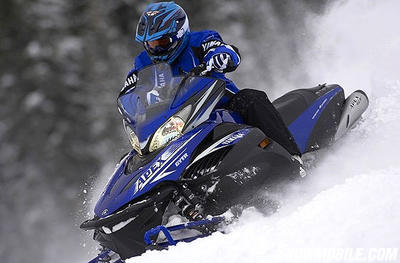





 Your Privacy Choices
Your Privacy Choices